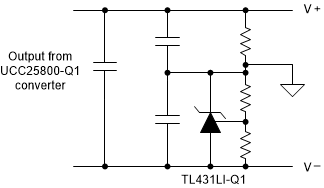SLUAAB9A March 2021 – December 2021 UCC25800-Q1
- Trademarks
- 1 Introduction
- 2 Open-Loop LLC Converter Operation Principle
- 3 Primary-side and Secondary-side Resonant Configurations
- 4 Rectification Methods
- 5 LLC Transformer Design Steps
- 6 Negative Voltage Generation
- 7 Multiple-output Design
- 8 EMI Performance
- 9 Common-Mode Transient Immunity (CMTI)
- 10Summary
- 11Revision History
6.2 Using a Shunt Regulator
The Zener diode provides a simple and cost effective solution. However, due to the tolerances on the Zener voltage, it might not meet the voltage regulation requirement. A more accurate shunt regulator can be used to improve the voltage regulation, as shown in Figure 6-2.
 |
|
| (a) Regulated negative voltage | (b) Regulated positive voltage |
In the example of regulated negative voltage, the negative output is regulated by the shunt regulator. The remaining of the voltage is left on the positive output.